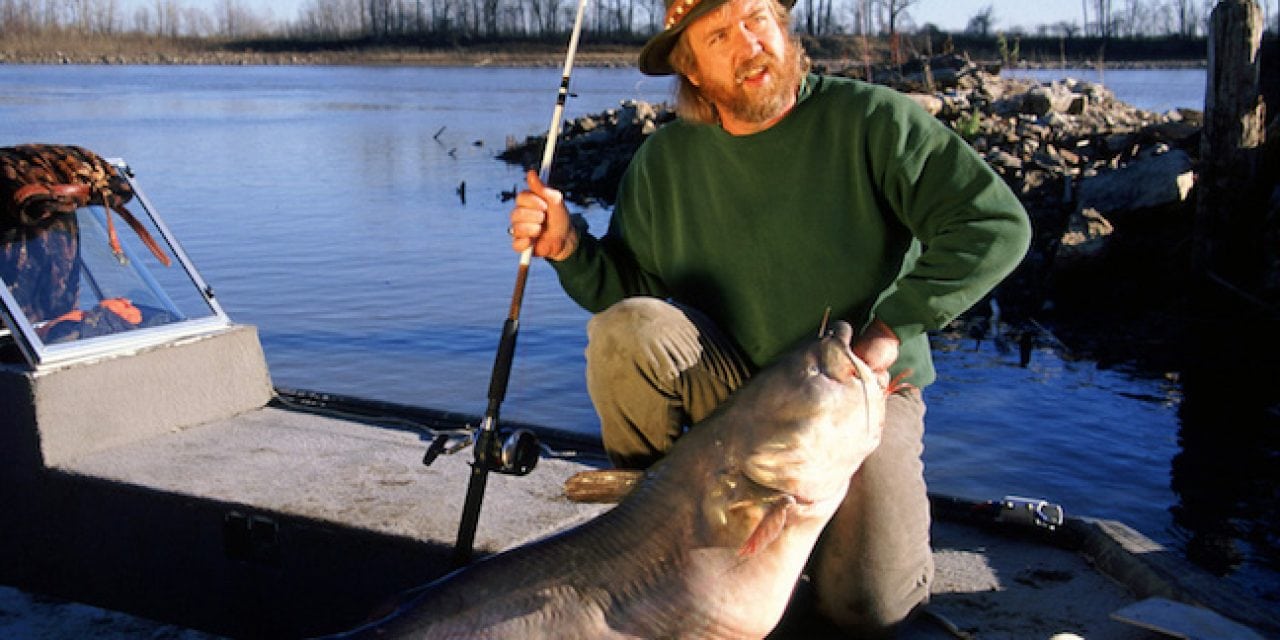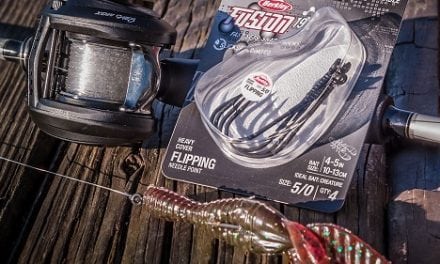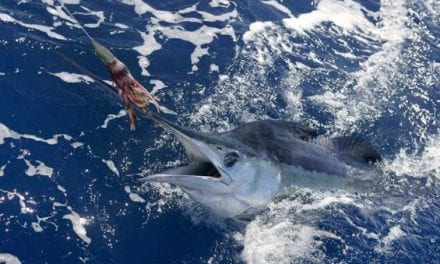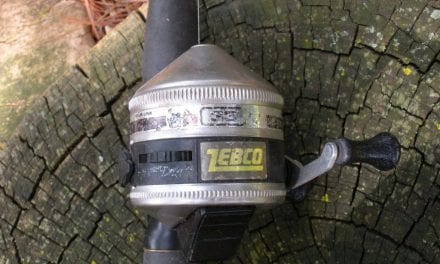During the fall turnover catfish may be found in deep waters, shallow waters or anywhere in between.
In the summer, many lakes teeming with catfish stratify into three distinct layers.
These lakes have a layer of cold, poorly oxygenated water on the bottom, and a layer of warm, moderately oxygenated water on top. Because cold water is heavier than warm water (to a certain degree), the warmer water stays on top and colder water sinks to the bottom.
In between lies a layer of cool, oxygen-rich water called the thermocline. Summer catfish usually stay in or near the thermocline in stratified lakes, because that layer best satisfies their needs for proper oxygen levels and water temperature.
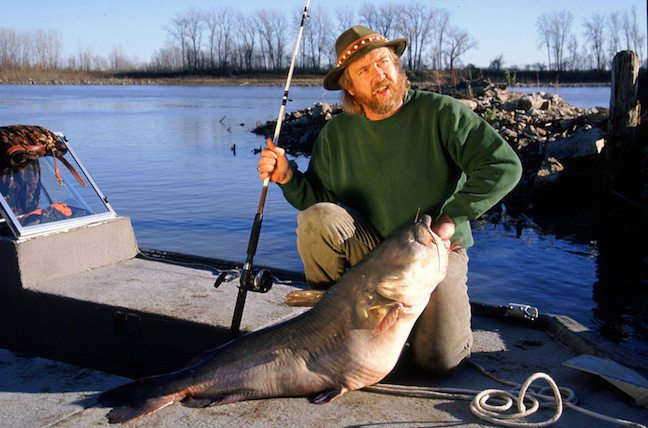
Rivers don’t “turn over” like many lakes, so anglers can fish these flowing waters and avoid the trauma of “turnover turmoil.” Trophy cats are easier to find this season because they’re more likely to be roaming the shallows. (Photo by Matt Sutton)
In late summer, fall or early winter (the exact time depends largely on the latitude in which the lake lies), cool weather begins lowering the surface water temperature.
As the upper layer cools, it becomes heavier and sinks. This action forces the warmer, lighter water below back to the surface. This water subsequently is cooled, just as the previous surface layer was, and descends as it cools.
This mixing or “turnover” continues for several weeks until the thermocline disappears, and all water in the lake is roughly the same temperature. This mixing effect also replenishes oxygen in deep water.
The end result is that fish formerly restricted to narrow bands of acceptable oxygen and temperature levels are no longer limited in their movements.
Catfish once barred from dropping into the coolest depths because of low oxygen levels now may roam freely to much deeper water. Likewise, where once fish could not spend extended periods in extreme shallows due to high temperatures and low oxygen levels, after turnover even these areas are acceptable.
Catfish now may be found in deep waters, shallow waters or anywhere in between, and the scattered schools often become difficult to pinpoint.
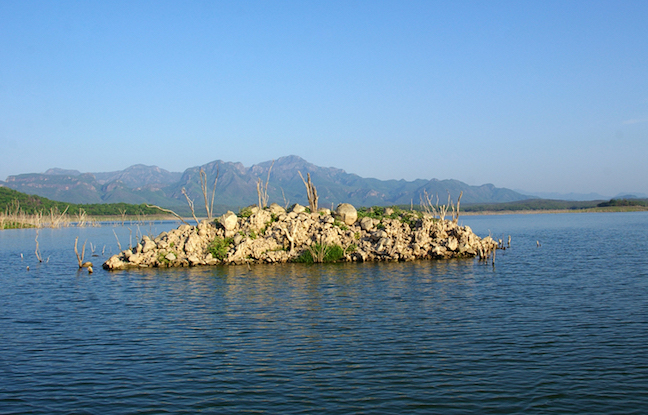
If the water rises to cover it, this brush-covered hump in mid-lake will be a prime hotspot for turnover catfish. (Photo by Keith Sutton)
Turnover Signs
On many lakes, turnover is clearly visible. A water color change is evident as circulating water brings up bottom debris. The water may take on a milky or brownish tint and smell like rotten eggs or decaying vegetation.
Turnover in some lakes is invisible, however, and therefore confusing even to those familiar with the phenomenon. In these waters, the only indication turnover is occurring may be distinct changes in catfish behavior after a few weeks of cool weather.
For instance, catfish caught on deep humps one week may be ambushing baitfish near shorelines the next.
Some waters don’t experience turnover because they don’t stratify in summer. Most rivers are a case in point. So are many large, shallow, windswept lakes and some reservoirs with lock-and-dam facilities or hydroelectric generators. In extreme southern areas, south Louisiana for example, temperatures may not drop low enough for turnover to occur.
Finding Turnover Cats
The secret to turnover fishing success is realizing that catfish still concentrate in areas that provide the most comfortable living conditions, and then learning to identify those areas.
Theoretically, conditions are now such that catfish can live anywhere within the lake. In actuality, factors such as oxygen content, light penetration and food availability still greatly influence a catfish’s choice of living quarters.
Consider, for instance, that all the debris and poorly oxygenated water being pushed upward from the lake bed when turnover begins temporarily “trashes” the whole system.
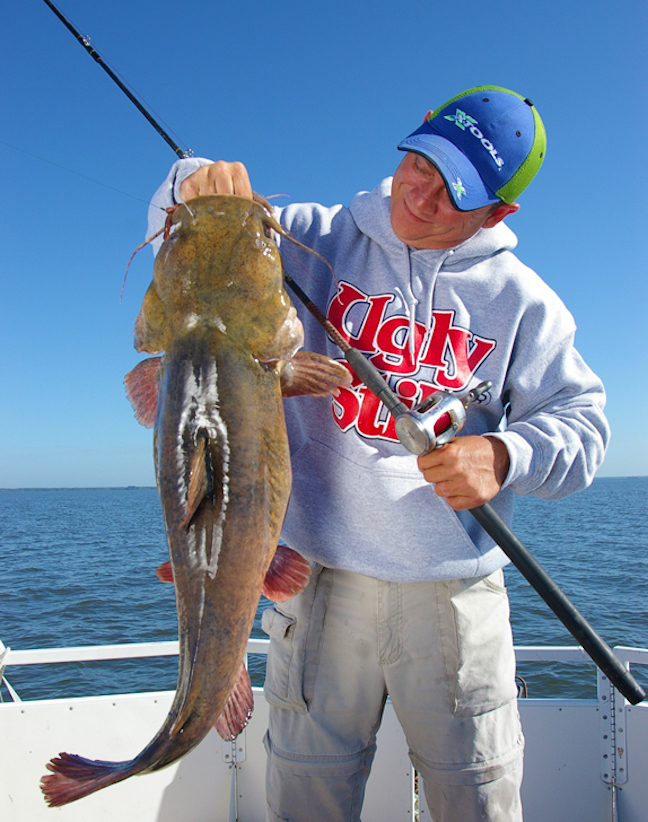
In fall, when fishing lakes that were stratified during summer, catfish anglers must learn to cope with vastly different water conditions that dictate where cats will be actively hunting and feeding. (Photo by Keith Sutton)
Catfish respond by seeking areas with better water quality. To find them, anglers should do likewise. An easy way to do this is to work tributaries bringing fresh water into the lake.
Another way is to look for areas where turnover hasn’t begun. On some large lakes, different arms of the lake turn over at different times, and anglers can concentrate their efforts in areas that aren’t visibly affected.
When turnover causes excessive amounts of decaying debris to circulate in the water column, sudden significant drops in oxygen can result.
When this happens, catfish must find oxygenated water immediately. They frequently solve the problem by going directly to the nearest source: surface aeration from wind and waves. Consequently, windswept shorelines in fairly shallow cover may be productive catfishing spots.
Other places you can find turnover catfish action are almost innumerable.
Long, sloping points are always a good possibility, as are humps and inundated islands. Cats like old fence rows that run from shallow to deep water, and large trees that have toppled into fairly deep water near the shoreline should definitely be investigated.
Other favorite areas include Christmas tree fish attractors, timbered areas edging underwater ditches and ponds, submerged rock piles, stump fields and saddle areas between two islands.
River Fishing
Because rivers are relatively unaffected by turnover, they provide an excellent alternative for anglers dealing with “turnover turmoil.”
In summer, high temperatures may drive river catfish to deep-water haunts in or near the main river channel.
Autumn offers more moderate water temperatures, allowing catfish to reinvade shallow, off-channel areas where they were found during spring. During this season, more than others, they’re often found in backwaters, river-connected oxbows and other areas where current is negligible.
Because the water in these areas is shallower, these catfish are easier to find, too. And they’re often more aggressive than they were during summer — hungry and eager to bite.
During late weeks of summer and early weeks of fall, look for river cats near wing dikes, log jams, big snags and other current-breaking structure in or near the main body of the river.
Fall Transition Channel Cats (Video)
As air and water temperature drop and autumn gets in full swing, you’ll find a lot of them near willows, cypress trees and other woody cover off the main river in oxbows and backwaters. As autumn turns to winter, look for catfish moving back to deep-water haunts near the main river channel.
Be patient and persistent. Turnover forces fish to roam, thus fishermen must also be willing to move frequently, forsaking likely looking spots or those that produced yesterday. If the tactics covered here don’t produce catfish, improvise another strategy and keep trying.
The transition from summer to autumn is jolting for both fish and fishermen. Catfish find their once secure world literally turned over on them.
Catfish anglers find their quarry more unpredictable than ever. Overcoming this seasonal nemesis requires all the skill, knowledge, and patience you can muster.
But when you finally zero in on a big autumn cat, you’re sure to agree that the rewards make the extra effort worthwhile.
The post Tips for Turnover Catfish When Their World Goes Topsy-Turvy appeared first on Game & Fish.

